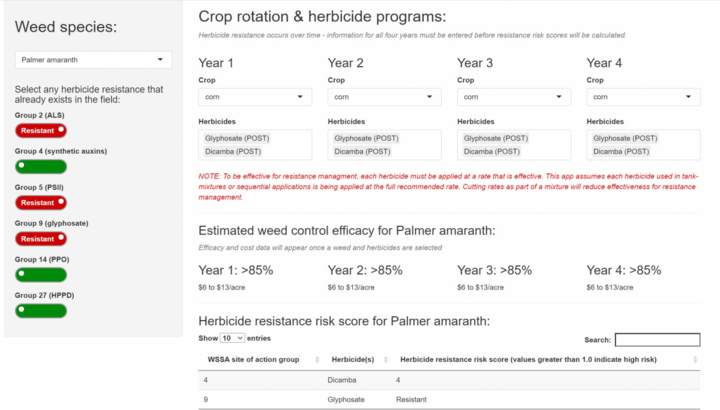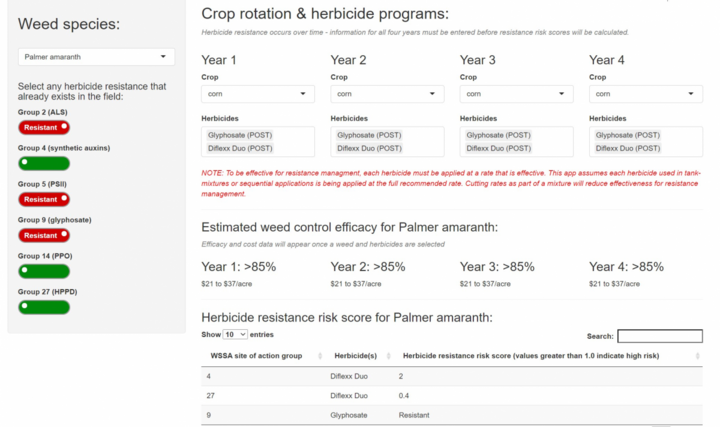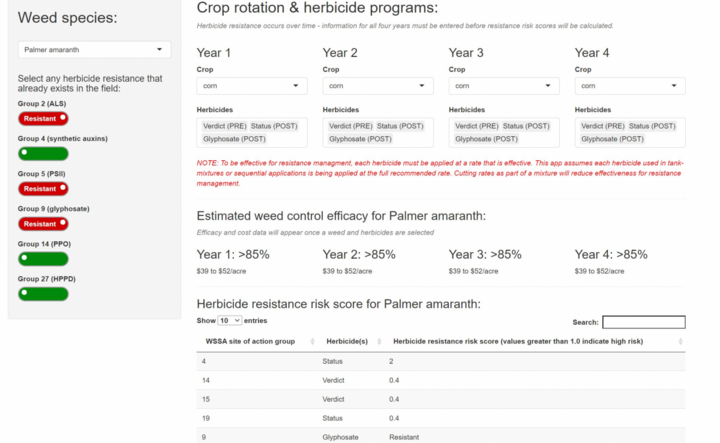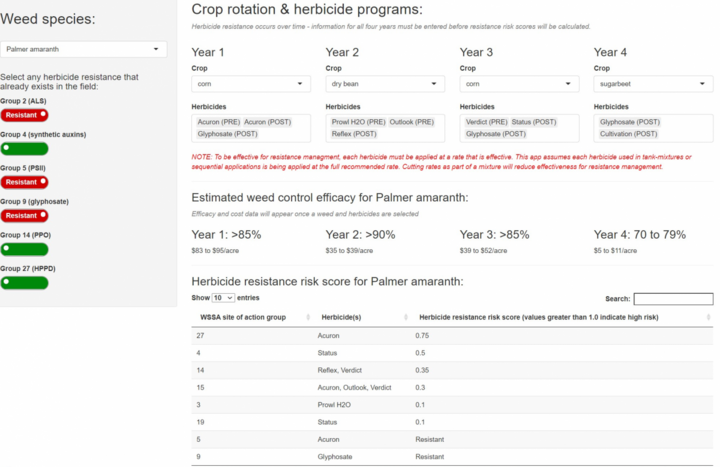Herbicides work by interfering with specific, essential biochemical pathways in plants. There are dozens of ‘target sites’ to which herbicides can bind to disrupt plant growth, each referred to as a site of action. To reach the site of action, all herbicides must first be absorbed into a plant and then move through the plant to reach the target. Weeds in a field are not identical, and even neighboring plants of the same species can vary in how they absorb, move or interact with an herbicide. There are often many millions of weeds present in one field, so we should expect that within the field there is a high likelihood that a single weed will be capable of surviving an herbicide application.
Herbicides don’t cause plants to be resistant, they remove all the susceptible weeds from the field, leaving only the resistant plant(s). A surviving plant or two may not be noticed, but it may be capable of producing thousands of seeds. And once several thousand herbicide-resistant seeds have entered the soil seedbank, the farmer has a problem.
Herbicide-resistant weeds are difficult to manage once established. Weed seeds can stay dormant and alive in the soil for decades. Because of the long-lived nature of seeds within the soil, rotating away from a specific herbicide for a season or even several years is not sufficient to address herbicide-resistant weeds.
One of the most successful strategies for managing herbicide-resistant weeds is applying multiple types of herbicides, known as mixing modes-of-action, at the same time. The logic of this approach is that the probability of a weed within a given field being resistant to an herbicide might be one in a million, and there are millions of weeds in a field. But the possibility of a weed being resistant to two different types of herbicides at the same time may be one in a billion. This approach works, and a large body of field research and population modeling backs it up. However, depending on which crops a farmer grows, what weeds are in the field, and the economics of adding extra herbicides to a spray tank, using multiple modes of action can be a nearly impossible solution to implement.
The Herbicide Resistance Risk Calculator was developed to help farmers make these challenging decisions. This is an interactive online web application which allows a farmer to choose a weed they are currently managing, or are concerned about, enter a four-year crop rotation, and select herbicides for each crop. The application then estimates 1) the effectiveness of each herbicide program, 2) the risk of resistance developing to each herbicide mode of action used in the rotation, and 3) the cost of each herbicide program.
How is the Program Used?
The web-based calculator is based upon some simple models and therefore, results should not be thought of as a scientifically exact prediction of what will happen based on the herbicide choices a farmer makes. Rather, the program assesses how effectively an herbicide controls a weed, how many times the herbicide is used in a rotation and whether effective mixtures are being used. In order to calculate an herbicide resistance risk score, four years of crops need to be entered, but the same crop can be chosen for each year of the rotation. Once herbicides are chosen for all four years and a weed species is selected, the model will calculate an herbicide resistance risk score for each herbicide site of action that was selected.
Risk scores are estimated on a scale of 0 to 4. A minimum score of 0 means the herbicide site of action was never used during the four-year period (and thus those sites of action are not presented in the table). Each year during the rotation an effective herbicide is used on the target weed, that herbicide site of action is initially given a score of 1; however, this score is reduced if a second effective site of action is applied in the same year. If an effective site of action is applied alone in each of the four years, it would result in the maximum risk score of 4.
The risk score is reduced by an amount that depends on the efficacy of the second SOA. For example, if a second herbicide site of action provides excellent control of the target weed, the resistance risk score is reduced more than if a second herbicide provides marginal control.
The lower the risk score, the less likely it is the weed population will become resistant. From a practical resistance management perspective, the goal when selecting herbicides should be to keep the total four-year risk score below 1.0. To accomplish this, the user must ensure that each time an effective herbicide is used, it is combined with a second herbicide site of action that is also effective on the target weed. Risk values less than 1 indicate a SOA was never used without a second effective site of action, and therefore, the risk of resistance is relatively low.
Example 1: Continuous Corn Rotation, POST Only Weed Control Program, and One Effective Herbicide Site of Action.
A four-year rotation of continuous corn is chosen, and an herbicide program for each year is also selected. In this example a single POST application of glyphosate + dicamba is chosen (Figure 1). For each herbicide program, a weed control efficacy and a risk score of developing herbicide resistance to any mode of action used are calculated. Weed control efficacy ranges from 0% to 100%. For any given year in the rotation, the risk of development of herbicide resistance for a mode of action ranges from “0” (low risk because the herbicide is not used), to “1” (high risk, because the herbicide is the only effective herbicide on the target weed). The Palmer amaranth in this example is already resistant to glyphosate, so a resistant risk score isn’t calculated for that site of action, and glyphosate does not contribute to the estimated weed control efficacy. The estimated weed control efficacy is calculated exclusively from the control estimated from dicamba and is greater than 85%. In this case, only having one effective herbicide being used gives an herbicide resistance risk score of “1” for each year for dicamba-resistance developing. As dicamba is the only herbicide used for all four years, the cumulative resistance risk is “4”, which is the highest possible score. There is a very high likelihood of Palmer amaranth developing dicamba-resistance in this scenario.

Example 2: Continuous Corn Rotation, POST Only Weed Control Program, and Two Effective Herbicide Sites of Action.
Using the same resistant weed population and crop rotation we now replace dicamba alone with Diflexx Duo®, which is a premix product containing dicamba (Group 4) and tembotrione (Group 27). The first thing to note is that both herbicides do not provide the same level of control. Tembotrione does not control Palmer amaranth as well as dicamba alone. When multiple modes of action are applied at the same time, the web app selects the herbicide which provides the greatest amount of control, in this case dicamba, and uses that rating to estimate the level of control. Therefore, control did not increase even though an additional mode of action was added compared to the first example. In this way, the weed control estimates from herbicide mixtures are fairly conservative. However, the cost per acre and the herbicide resistance risk score did change (Figure 2). In the first scenario, dicamba was applied without any other effective mode of action, resulting in the highest possible score of “4”. Now that dicamba is being applied with another mode of action each year, that risk was reduced by half to “2” over four years – still greater than the ideal score of less than 1, but an improvement over dicamba used alone. The resistance risk score for group 27 herbicides, however, is much lower, at “0.4” over four years. This is largely because the second herbicide in the mixture (dicamba) is effective on the target weed, and is likely to control any individuals that survive the tembotrione.

Example 3: Continuous Corn Rotation, PRE/POST Weed Control Program, and Multiple Effective Herbicide Sites of Action.
For another example we move from a POST only herbicide program to a split PRE/POST program, still in continuous corn and using the same herbicide-resistant Palmer amaranth population. Here (Figure 3), we use Verdict® PRE followed by Status® and glyphosate POST. Once again glyphosate is ineffective as the Palmer population is resistant and we see no calculation of an herbicide resistance risk score for glyphosate. Status® is a premix of dicamba (Group 4) and diflufenzopyr (Group 19). The risk of resistance developing resistance to the group 4 mode of action in this example is the same as that of the example 2. Again, dicamba is providing the bulk of Palmer control in the Status® premix compared to the diflufenzopyr, and consequently, the risk of resistance is biased towards the herbicide which provides more of the control. The risk of resistance for the components of Verdict®, saflufenacil (Group 14) and dimethenamid-p (Group 15) is relatively low. This is because both herbicides are being ‘protected’ as both herbicides have a high efficacy independent of one another. To lower the resistance score, we should choose two equally effective modes of action in the same application.

Example 4. Management of Herbicide-resistant Palmer Amaranth in a Corn / Dry Bean / Corn / Sugarbeet Rotation
In this crop rotation example, herbicide options exist to manage herbicide-resistant Palmer amaranth in every crop but sugarbeet. In the sugarbeet crop cultivation is used for weed control, and assigned a control value of around 70% with the assumption that in-crop cultivation will eliminate about 70% of the weeds (Figure 4). We see that there are no herbicide resistance risk scores given for cultivation, and herbicide groups 9 (glyphosate) and 5 (atrazine in Acuron®) are marked as already resistant in the herbicide resistance risk score. With a four-year rotation of three different crops, there is a greater number of herbicide modes of action used compared to previous examples with continuous corn. Having a more diverse cropping system is lessening the cumulative use of particular herbicide sites of action, and consequently decreases herbicide resistant risk scores. In general, as cropping system diversity increases, the number of herbicide resistant weed populations decrease. We see the highest risk calculated for group 27 herbicides, as one component of Acuron® is used twice in the first year, group 4 herbicides as the site of action is used once in year three without any other effective site of action, and group 14 herbicides as they are used both in year 2 and year 3. But because all risk scores are less than 1, this appears to be a low-risk program for developing additional herbicide resistance in Palmer amaranth. It should be noted, however, that in the sugarbeet crop, Palmer amaranth control is only being provided by the tillage operation, and therefore, high weed densities will require additional weed control operations.

How Should This Program Be Used?
We recommend using the Herbicide Resistance Risk Calculator as a tool to assess your current weed management plan and to plan for the future. We envision farmers experimenting with different products prior to purchasing herbicides for the spring, and hopefully aiding users in thinking about weed management as a multi-year plan. This tool should be considered a supplement to existing herbicide resources, such as herbicide labels and the Guide for Weed Management in Nebraska. The greatest asset of this web app is that it allows users to quickly compare medium-term plans for their operations. It is not meant to be a comprehensive weed management tool. All of the weed control efficacy data and price estimates were taken from the Guide for Weed Management in Nebraska, but this web app does not include nearly the same level of detail. The Guide for Weed Management in Nebraska has additional information on recommended adjuvant and nozzle selection, and most importantly herbicide rotation restrictions. One key piece of information missing from the current version of this web app is herbicide rotation restrictions. Many of the herbicide options a user can plug into this program will lead to crop injury and yield loss if label restrictions are not followed. Please double check any herbicide programs selected in the Herbicide Resistant Risk Calculator against herbicide labels and the Guide for Weed Management in Nebraska before choosing an herbicide program.
Short to Medium-term Plans to Improve the Web App
The short- to medium-term goal is to add rotation restrictions and extend the model to cover other crops and weeds. The eventual is goal is to provide resistance risk scores that can be interpreted quantitatively. That is, we hope to get the web app to estimate the percent chance of developing resistance. Also, we hope to get the web app to provide herbicide and crop rotation recommendations for effective herbicide resistance management in the future.
Acknowledgements
- Development of this program was funded by the Western Sugar Cooperative.
- Use of product names is for demonstration only and not an endorsement.
- Please contact the authors of this article if you have suggestions for improvement or find errors in the web app.
